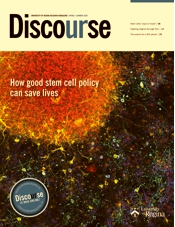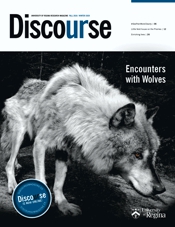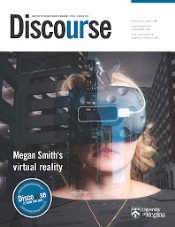
What started as an idea being casually bounced around between board members of the Regina International Film Festival and Awards (RIFFA) has grown into something much loftier than first imagined.
“RIFFA board members John Thimothy and Nesita Watsemwa came to me about four years ago to see if I was interested in creating a mental health film initiative,” says Trevor Grant, a University of Regina School of Journalism faculty member and graduate studies coordinator. “I immediately latched onto the idea and it wouldn’t let me go until I saw it through.”
Thanks to Grant’s dedication and tenacity, LOOK: A Mental Health/Film Initiative is now a reality.

For Grant, who has spent most of his life making documentaries and television programs, and who now teaches in the journalism school, an initiative like LOOK was long overdue.
“Its core purpose is to bring together individuals who have substantive mental health illnesses,” says Grant, who is the initiative’s educational and co-creative director. “It’s also about self-expression, about revealing to society why marginalized voices matter, and how those voices can provoke an audience to reconsider their own stereotypes.”
It’s something Grant is passionate about, since he knows all too well what it means to struggle with good mental health, as those struggles were one of the big reasons he left high school before finishing grade 12.
“If there had been a LOOK program available to me, a place to go and be creative, and be with people with similar issues in life, then maybe I could have headed down a different, more positive road,” says Grant.
A PERFECT MATCH
Grant’s love of filmmaking has helped him immensely. That’s why he’s volunteered so much of his time to kickstart the LOOK initiative, and to keep it free for participants.
It’s also what drove RIFFA to reach out to the Saskatchewan Health Authority and the Canadian Mental Health Association’s Saskatchewan Division when looking for collaborators.
It was a perfect match.
In order to be considered for the program, participants have to be between 17 and 30 years old, and they must be referred by professionals who work in mental health.
Grant says he has also received significant support from the University’s journalism faculty, who were pivotal in ensuring LOOK became a reality.
“We were looking for a space to do this, so I asked my colleagues if we could use the school’s TV studio, and all of the faculty said ‘yes, absolutely,’” says Grant. This partnership gives the LOOK participants access to the journalism school’s state-of-the-art studio.
The equipment the participants use–the cameras, lights, mics, and the Adobe subscriptions for editing–were paid for by LOOK as a result of a fundraiser and a few private donations.
Even with a location and equipment secured, Grant knew he needed more help to make the program a success.
“I very quickly reached out to my long-time filmmaker friend and fellow J-School instructor Layton Burton.”
Burton, who is the School of Journalism’s lab instructor, jumped at the opportunity to be a part of the initiative. He is now LOOK’s co-creative director.
“People in my family have had mental health issues, so I was immediately drawn to the idea. And, once Trevor and I get involved in something, we don’t wait for someone else to do it – we work to make it happen,” says Burton.
Burton says he feels great about all the work that’s gone into getting LOOK off the ground, especially when he sees “the smiles on the young people’s faces when they are working on their films. Seeing the results of their hard work is more payment than I will ever need.”
Which is fitting, considering LOOK is a completely volunteer-based program.
“We’ve had overwhelming support from professional journalists, filmmakers, cinematographers, and other industry professionals who volunteer their time to help mentor, support, and inspire our LOOK participants. Our goal is to build confidence in each student who walks through that door,” says Grant.

IN CLASS
LOOK held its first class in January 2019 with seven young people involved in the 20-week-long program. The second session has already begun and enrolment has doubled.
The class runs every Saturday and is designed much like Grant and Burton’s TV documentary courses in their journalism program.
“We cover a wide range of storytelling modes, from documentary and short-film production, to filmmaking theory, to hands-on experience with lights, cameras, and editing software,” explains Grant. “Participants then have time to create their own short films or documentaries.”
The topics the first class delved into ranged from creative expression with puppetry to a personal exploration of bi-polar and depressive disorder to an old-fashioned love story.
 Trevor Grant 300 feet above Cape Town, South Africa while directing and filming a TV documentary. (Photo by Dugald McLaren)
Trevor Grant 300 feet above Cape Town, South Africa while directing and filming a TV documentary. (Photo by Dugald McLaren)
One major difference between the journalism school class and the LOOK program, however, is how Burton and Grant engage with the materials and the participants.
“Our approach revolves around having an understanding of mental health issues,” says Burton.
Due to the involvement of the Saskatchewan Health Authority and the Canadian Mental Health Association, confidentiality plays a central role. But one student, who graduated from last year’s LOOK program, didn’t hesitate to speak about her experience.
“I was really nervous at the beginning,” says Kayla Mak Harrison. “But they gave me the support I needed, they understood me as a person, and they helped me to see how the camera could become another part of me and help me to tell my story.”
Harrison, who identifies as Inuit and Chinese, says she found it challenging to open up and get comfortable in the new environment when she first arrived at the School of Journalism’s studio. And, she admits, prior to the LOOK program, her only experience with a camera was taking photos – not video. But, with support from Grant and Burton, after only a few classes, her uncertainty turned to enthusiasm.
“I’ve never made a film. I’ve never made anything like that at all. So, for my first time, I was just, like, let’s see how this goes, and wherever it goes, it goes,” she says.
Harrison admits that producing the film took a lot of time and a lot of work, but says it was worth it. “Going to the Regina International Film Festival and Awards and having my film screened – all of those experiences really broadened my horizons.”
Grant says that from the beginning, the idea for LOOK was to have a film screening of the participants’ work at RIFFA. No one really knew how that would play out – whether participants would want to attend the event and screen their work due to the social stigmas attached to having poor mental health.
“I made the film thinking that people were going to judge it, judge me, and not understand where I was coming from,” says Harrison.
Though many participants chose to remain anonymous, Harrison stepped into the spotlight on RIFFA’s opening night.

Her film, Romeo and Mental, tells the story of two people living with major depression and bi-polar disorder. She based one of the characters on herself. But, because of the stigma associated with mental health disorders, Harrison says it was difficult to find people to take on that role.
“I tried to find people to play the female role in my film, but it ended up taking too much time,” says Harrison. “And anybody who considered it wanted to be blacked out like a shadow to keep them anonymous.”
Since Harrison didn’t want to silhouette her character, she took on the challenge of not only making the film, but also starring in it.
The risk paid off.
“Playing my own role helped me to better understand myself.” But, she says, it wasn’t an easy decision for her to make.
“I was afraid that people were going to see me in a different light,” says Harrison. “I was unsure if the audience was going to understand the part of my life I was trying to capture on film.”
That wasn’t the case.
“After it screened, a lot of people came up to me and said, ‘WOW!’ It really opened them up to better understand what a person with major depression and bi-polar disorder feels, and to understand what happens to them,” says Harrison.
CHALLENGING PERCEPTIONS
Dianne Allen, a social worker with the Saskatchewan Health Authority, was an advocate of the LOOK program from day one. Working in mental health, Allen understands the complexity of telling these kinds of stories.

“These young filmmakers wonder if people who know they have lived experiences of mental health issues will someday hold it against them – whether they are looking for jobs or for some other reason.”
Allen says it becomes even more complicated for a few of the young people participating in LOOK because some of them live with some form of psychosis, which, she explains, is “a fancy word for having trouble with reality.”
“Psychotic disorders, such as schizophrenia, schizoaffective, and bipolar, typically develop in the late teens or early 20s when young people attend university, begin working, start their careers. Mental illness disrupts this developmental process and timeline, which leaves young adults with mental illness on the sidelines and left out. The LOOK project was designed for this age group, providing them a much-needed opportunity,” says Allen.
For Allen, the LOOK films and documentaries challenge people’s perceptions of mental health issues, while the participants are provided with some much-needed confidence.
“The fact that they were even able to participate in this program shows their strength. The participants had something valuable to say, and they received positive feedback from Trevor – who made it so fun and supportive from day one,” says Allen. “These young people who were super shy, who hardly talked to people, started to connect with others. And to watch it happen was wonderful.”
Allen was in attendance at the initiative’s premiere screening and reminisces about one participant’s experience at the gala.
“She was standing on stage and said, ‘I have found my voice.’ Here she was, amongst professional filmmakers, answering the public’s questions, and we were just like, ‘Oh my gosh.’ That young person, who has had a difficult past, who had no voice, was standing up there with her head held high.”
Allen, who has recently taken on the volunteer role of director of community relations within the LOOK initiative, notes that building confidence is an important part of the recovery journey for individuals living with mental health issues – and that building and rebuilding confidence and building and rebuilding social networks are always difficult.
“Seeing what LOOK has done for some of these young people in the span of six months, in what usually takes years to achieve, is profound,” says Allen.
Now in its second year, LOOK is fully enrolled with 14 first-time participants, as well as some returning students who are enrolled in an advanced production course – a class Grant created simply because some of last year’s students wanted to continue with the program.
“They wanted to learn more and to go further, so we just had to make it happen,” says Grant.
While there is volunteer and in-kind support from the University of Regina’s School of Journalism, in order to successfully continue, Grant says LOOK needs more help. The most immediate need is laptop computers to give the participants an opportunity to edit their work on their own time.
“Mental illness is a severe problem. For youth, it’s imperative that we begin to deal with it early and realize it can take a long time to make a change. That’s why we need people to give to this initiative,” says Grant, who believes that LOOK is making a big difference in the lives of those who are a part of it.
“Filmmaking is a powerful tool for creating connections and getting conversations started around complex issues related to mental health. Through filmmaking, we have the opportunity to fight stigma and to create better outcomes for young people.”
Click here for more information about LOOK: A Mental Health/Film Initiative.












